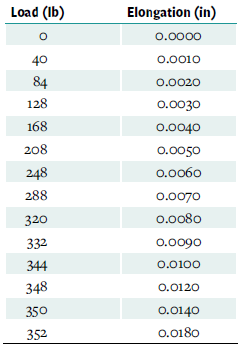3. A 48-inch-long aluminum bar (E = 10,000 ksi) consists of two, 24-inch long sections.
Section AB is 4.0 inches in diameter, and section BC is 2.5 inches in diameter. Thebar is loaded in tension by a force, P = 25 kips. Determine the total elongation of the aluminum bar under this load.

4. The following data were obtained from a tension test. The specimen’s cross-section is circular (0.200 inches in diameter), and its original length was 3.000 inches. Assume the cross-section stays constant during the loading.

a. Convert loads to stresses (psi) and elongation to strain. Make a table to show this result.
b. Plot the stress-strain diagram.
c. Determine the strain energy density and the strain energy from 0 percent to 0.2 percent strain.
d. Determine the yield strength for 0.1 percent offset.
e. Determine the ultimate strength of the material.
f. Determine the initial tangent modulus of elasticity.
g. Determine the secant modulus for an axial strain of 0.4 percent.

